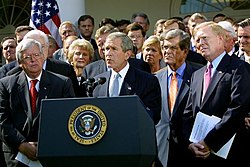
Back مقدمات حرب العراق Arabic Antecedentes de la guerra de Irak Spanish پیشدرآمد جنگ عراق Persian Awal mula Perang Irak ID
| Prelude to the Iraq War | |||||||
|---|---|---|---|---|---|---|---|
| Part of the War on terror and the Iraq War | |||||||
Clockwise from top-left: An American helicopter shadows a Russian oil tanker to enforce sanctions against Iraq; Two US F-16 Fighting Falcons prepare to depart Prince Sultan Air Base in Saudi Arabia for a patrol as part of Operation Southern Watch, 2000; An Iraqi surface-to-air missile firing at a coalition aircraft, July 2001; A UN weapons inspector in Iraq, 2002; President George Bush, surrounded by leaders of the House and Senate, announces the Joint Resolution to Authorize the Use of United States Armed Forces Against Iraq, 2 October 2002; US Marine M1A1 tank is off-loaded from a US Navy LCAC in Kuwait in February 2003; Anti war protest in London, 2002; US Secretary of State Colin Powell holding a model vial of anthrax while giving the presentation to the United Nations Security Council on 5 February 2003 | |||||||
| |||||||
| Belligerents | |||||||
|
Coalition of the willing
|
| ||||||
| Commanders and leaders | |||||||
|
|
| ||||||
Shortly after the September 11 attacks, the United States under the administration of George W. Bush, actively pressed for military action against Iraq, claiming that Iraqi leader Saddam Hussein was developing weapons of mass destruction and having ties with al-Qaeda. The United States and United Kingdom argued that Iraq's activities posed a threat to the international community.
During the 1990s, the U.S. and the U.K. pursued a policy of containment towards Iraq. Containment encompassed a United Nations inspections regime that was tasked with disarming Iraq of weapons of mass destruction, which was linked to an comprehensive embargo on that country. In addition, the U.S. and U.K. patrolled no fly zones that barred Iraqi aircraft from operating in northern and southern Iraq. However, by the end of the decade, containment eroded as relations became increasingly strained between the U.N. and Iraq, which ultimately culminated in the weapons inspectors being withdrawn from the country in late 1998. The U.S. and U.K. retaliated with a bombing campaign against Iraqi military targets. Following Desert Fox, Iraq openly challenged U.S. and U.K. aircraft patrolling the no fly zones, attempting to shoot down military aircraft. Concurrently, U.N. sanctions were becoming less enforced, as Iraq was able to manipulate the sanctions regime in its favor to convince more countries to lift the sanctions altogether.
As containment eroded, beginning in the late 1990s neoconservatives argued for the overthrow of Saddam Hussein's regime and democratization of Iraq. They justified overthrow on the basis that Ba'athist Iraq posed a direct threat to American security by threatening Middle East stability and secure access to oil with its weapons of mass destruction and missile programs, and that the United Nations was an ineffective tool in confronting this threat. Neoconservative advocacy would lead to the passing of the Iraq Liberation Act in late 1998, making regime change in Iraq as official U.S. policy. Following the election of George W. Bush as president in 2000, the U.S. moved towards a more aggressive Iraq policy. The Republican Party's campaign platform in the 2000 election called for "full implementation" of the Iraq Liberation Act as "a starting point" in a plan to "remove" Saddam.[1] Many neoconservatives would take up key positions in the Bush administration.
In the aftermath of the September 11 attacks, elements within the Bush administration believed that Iraq shared responsibility for the attacks, as well as having ties to al-Qaeda. Believing that a state sponsor was involved, many within the administration concurrently harbored a distrust towards the U.S. intelligence community for underestimating threats, and instead preferred utilizing outside analysis and intelligence from the Iraqi opposition that alleged an Iraq-al-Qaeda connection, as well as allegations that Iraq was developing weapons of mass destruction. Although military action was initially deferred in favor of invading Afghanistan, from September 2002 the U.S. began to formally present its case for action against Iraq at the United Nations. In November, the UN Security Council unanimously passed Resolution 1441, stating that Iraq was in material breach with its disarmament obligations and giving Iraq "a final opportunity to comply" that had been set out in several previous resolutions (Resolutions 660, 661, 678, 686, 687, 688, 707, 715, 986, and 1284).[2] Concurrently, an elaborate public relations campaign was waged to market military action to both the American and British publics, culminating in then-Secretary of State Colin Powell's February 2003 address to the Security Council.[3]
After failing to gain UN support for an UN authorization for an invasion, the U.S., together with the U.K. and small contingents from Australia, Poland, and Denmark, launched an invasion on 20 March 2003 under the authority of UN Security Council Resolution 660 and United Nations Security Council Resolution 678.[4] Following the invasion, no evidence of an active WMD program or ties to al-Qaeda was ever found.
- ^ "Republican Platform 2000". CNN. Archived from the original on 21 April 2006. Retrieved 25 May 2006.
- ^ "Text of U.N. resolution on Iraq - Nov. 8, 2002". CNN.com. Archived from the original on 22 November 2007. Retrieved 8 December 2007.
- ^ United Nations Security Council PV 4701. page 2. Colin Powell United States 5 February 2003. Retrieved 2007-07-17.
- ^ Bellinger, John. "Transatlantic Approaches to the International Legal Regime in an Age of Globalization and Terrorism". US State Department. Retrieved 2017-06-24.







